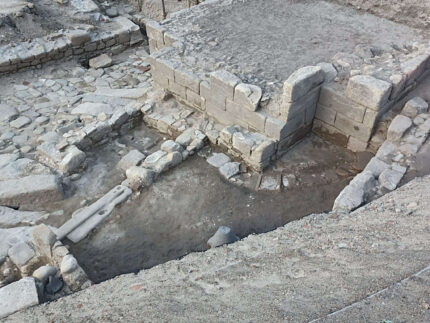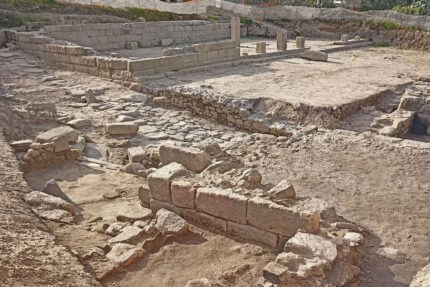 The remains of an imposing Greco-Roman era public structure have been unearthed in the small village of Tripi, in the Messina area of northeast Sicily. The stone block construction and a terrace identify the structure as the stoa, the open passage between colonnades that overlooked the agora, the political and commercial center of the Greek city. This discovery is key evidence confirming that modern-day Tripi was the location of the ancient city of Abakainon (Abacaenum to the Romans).
The remains of an imposing Greco-Roman era public structure have been unearthed in the small village of Tripi, in the Messina area of northeast Sicily. The stone block construction and a terrace identify the structure as the stoa, the open passage between colonnades that overlooked the agora, the political and commercial center of the Greek city. This discovery is key evidence confirming that modern-day Tripi was the location of the ancient city of Abakainon (Abacaenum to the Romans).
Unlike many other cities in Magna Graecia (the regions of southern Italy colonized and influenced by Greek settlers), Abakainon was not founded by colonists from Greece. It was part of the Greek sphere of influence, but it was a city of the Siculi, the local tribe of eastern Sicily and the island’s namesake. The date of its founding is unknown, but may go back as far as 1100 B.C. Ancient sources and numismatic evidence record the city as a thriving concern by the 5th century B.C. It was an important city, rich in agriculture and trade, and controlled a large territory from the Tyrrhenian Sea to the foothills of Mount Etna. It minted its own coins and was allied to Carthage in the First Punic War, putting it in the crosshairs of Rome.
Its alliance with Carthage and later its submission to Rome led to its destruction and subsequent disappearance. This was the accepted narrative until recent times. However, the discovery of coins during recent excavations seems to challenge this established story. Since the second half of the last century, there had been credible speculation about the true location of Abakainon in the territory of Tripi and its actual size. Excavation campaigns promoted by the current municipal administration have now unequivocally confirmed the presence of an ancient city of significant size and wealth, shedding new light on the history of this site.
 Tripi has a population of just 750 today, and the mayor is leaning heavily into its glorious ancient history as a means to stimulate tourist interest and a revival of population and business.
Tripi has a population of just 750 today, and the mayor is leaning heavily into its glorious ancient history as a means to stimulate tourist interest and a revival of population and business.
In Tripi, every corner of the village evokes the ancient grandeur of Abakainon, from the triumphal entrance surrounded by ceramics and fountains, to the bar in the heart of the old town, a community meeting point, to the traditional summer symposium. The castle, a witness to past eras and legends, offers spectacular views of the Aeolian Islands, while the urban architecture scattered throughout the hamlets of Casale, San Cono and Campogrande recalls the ancient layout of the town. Monumental necropolises from the late Classical and Hellenistic periods, such as that of Contrada Cardusa, testify to Abakainon’s prosperity and flourishing past. Here, early excavations uncovered gold jewelry and fine ornaments, evidence of the wealth and taste of the ancient inhabitants. The museum, currently being refunctionalized, preserves these artifacts, transforming itself into a kind of thousand-year-old jewelry store.
Today, with the holding of the referendum to change the town’s name to Tripi-Abakainon, the village also wants to definitively revive its social, economic and cultural development, thus sealing its rediscovered identity.